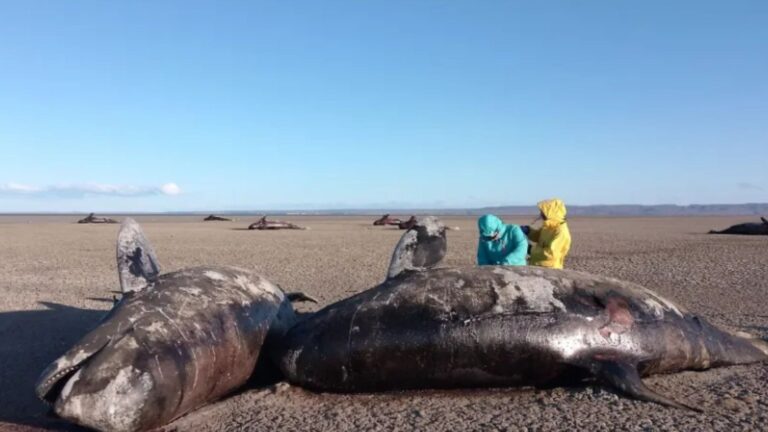SCIENTISTS have been left baffled after 26 orcas mysteriously washed up dead on a beach.
The mass stranding of the killer whales is now being investigated after experts revealed such a grim discovery has only been seen twice before.
Dozens of orca carcasses were found in San Sebastián Bay on the southern tip of Argentina this week.
It marked the first time multiple specimens from the ecotype D family or orcas have been stranded on the Atlantic coast of the Tierra del Fuego Province.
These killer whales are often identified by their distinctive features such as rounded heads, tiny eyepatches, and swept-back dorsal fins.
Experts from the National Scientific and Technical Research Council (CONICET) and the Southern Center for Scientific Investigation (CADIC) were first alerted to two lifeless bodies.
They went to investigate the pair which had washed up in the bay before making a shock discovery.
The team then found 24 more carcasses in hard-to-reach areas further north of the bay.
All were confirmed to be from the same ecotype D orcas.
Autopsies on the killer whales showed no signs of injuries or trauma.
This led scientists to believe they weren’t involved in any collisions with vessels out at sea or caught in fishing nets.
Based on the decomposition of the animals, it has been widely agreed that the majority of the group washed ashore at the same time.
This has left orca experts scrambling to discover just why and how they all became stranded in one area.
CONICET spokesperson Mónica Torres said: “What really surprised us in this case was the number of specimens in total.
“We’ve been monitoring the bay and entire Atlantic coast of Tierra del Fuego all year round for over 10 years, and we’ve never recorded so many stranded animals before.
“Something unusual is that they are orcas, which are not whales but rather dolphins, the largest of the dolphin group.
“These in particular are called an ecotype, which is like a species within the orca group that’s not well known. That also caught our attention.”
Mónica added that further tests will be carried out on the carcasses which will see them be “opened up and looked for organ, tissue and internal injuries” before taking samples.
She added: “The idea is to try to identify the causes of the stranding.
“Sometimes it’s very difficult to determine the cause with cetaceans; you need to find the animals very fresh to assess whether they have internal injuries or any pathology that caused their death.
“Externally, we didn’t see any major wounds or marks from nets or any interaction that could have caused them to wash ashore.”
Mónica explained that San Sebastián Bay has a very gentle slope with a large tidal range of almost 56ft.
She said: “Perhaps animals that enter at high tide or when the tide goes out quickly can become stranded if they are not familiar with the area.”
“This is only the third stranding around the world and is something very rare.
“It happened once in New Zealand with quite a few orcas, about 17, then another nine were stranded in the Strait of Magellan in 2020, and this would be the third.”
CONICET say they are working around the clock to gather as much information as possible to determine the cause of death.
It added in a statement: “It is of great importance to have the support of the public at large to keep the specimens intact on the beach so we can have all the necessary information for the study.”
Experts say such an event involving ecotype D orcas has only ever been recorded twice before.

OMAZE-ING
I went from council flat to winning £4m house… But this is why I’m selling up

BOTTOMS UP
Wetherspoons reveals opening dates of 5 new pubs starting next week
The first was in New Zealand in 1955, when 17 sub-Antarctic killer whales washed ashore.
In 2020, nine others were stranded in Chile’s Strait of Magellan.


